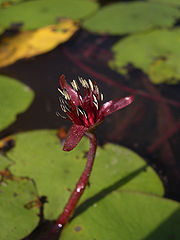Brasenia
| Brasenia subsp. var. | ||||||||||||||||||||||||||||||||||||||||||||||||||||||||
|---|---|---|---|---|---|---|---|---|---|---|---|---|---|---|---|---|---|---|---|---|---|---|---|---|---|---|---|---|---|---|---|---|---|---|---|---|---|---|---|---|---|---|---|---|---|---|---|---|---|---|---|---|---|---|---|---|

|
|
| ||||||||||||||||||||||||||||||||||||||||||||||||||||||
| ||||||||||||||||||||||||||||||||||||||||||||||||||||||||
Brasenia is a genus belonging to the family Cabombaceae, consisting of one extant species widely distributed in warm temperate and tropical regions of the world. Brasenia is an aquatic perennial plant with floating, peltate leaves and rhizomatous stems. It is identified by its bright green leaves, small purple flowers that bloom from June through September, and a thick mucilage that covers all of the underwater organs, including the underside of the leaves, stems, and developing buds. Brasenia exhibits wind pollination. The flowers have a two-day blooming period. On the first day, the functionally female, or pistillate flower, extends above the surface of the water and exposes the receptive stigmas. The flower then recedes below the water surface and on the following day emerges as a functionally male, or staminate flower. It is elevated higher than on the previous day and the anther-bearing filaments are extended beyond the female carpels. The anthers dehisce, releasing the pollen, and the flower is then withdrawn below the water where the fruit develops. Brasenia spreads rapidly once it is established and is very difficult to control. Brasenia schreberi (syn. B. nymphoides, B. peltata) has the common name water-shield (also watershield or water shield).
The genus commemorates the surgeon and Moravian missionary Christoph Brasen (1738-1774).
| Standard Cyclopedia of Horticulture |
|---|
|
Brasenia (meaning unexplained). Nymphaeaceae. Water-shield or -target. One species of aquatic plant widely distributed (in N. Amer., Asia. Afr., Austral.). Lvs. oval, entire, floating, centrally peltate; submerged parts coated with thick transparent jelly: fls. axillary near the summit of the st., small (½ in.), purple; sepals 3 or 4; petals 3 or 4, linear; stamens 12-18, on filiform filaments; carpels 4-18, separate, forming indehiscent 1-2-seeded pods. B. Schreberi, Gmel. (B. peltata, Pursh. B. purpurea, Casp.), is not a showy plant but is interesting and suitable for edgings of small aquatic gardens. Grows in 1-6 ft. of water. Easily prop. by division of roots or by seed.
|
Cultivation
Propagation
Pests and diseases
Varieties
Gallery
References
- Standard Cyclopedia of Horticulture, by L. H. Bailey, MacMillan Co., 1963
External links
- w:Brasenia. Some of the material on this page may be from Wikipedia, under the Creative Commons license.
- Brasenia QR Code (Size 50, 100, 200, 500)
